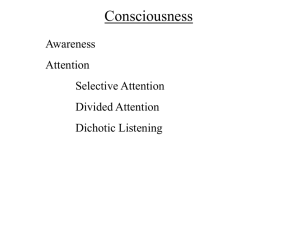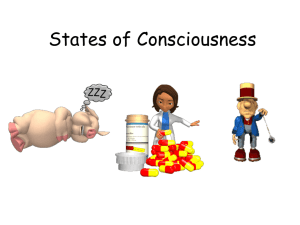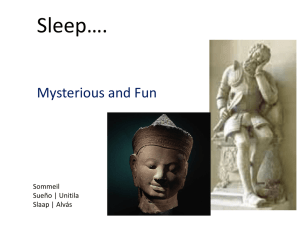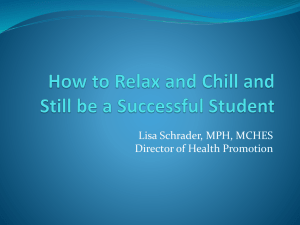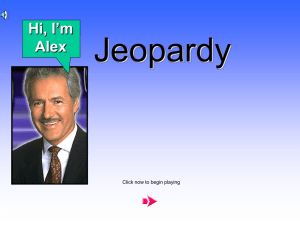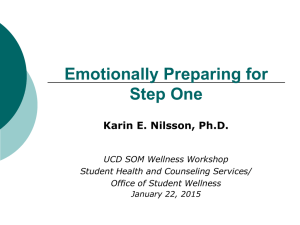Ch07
advertisement
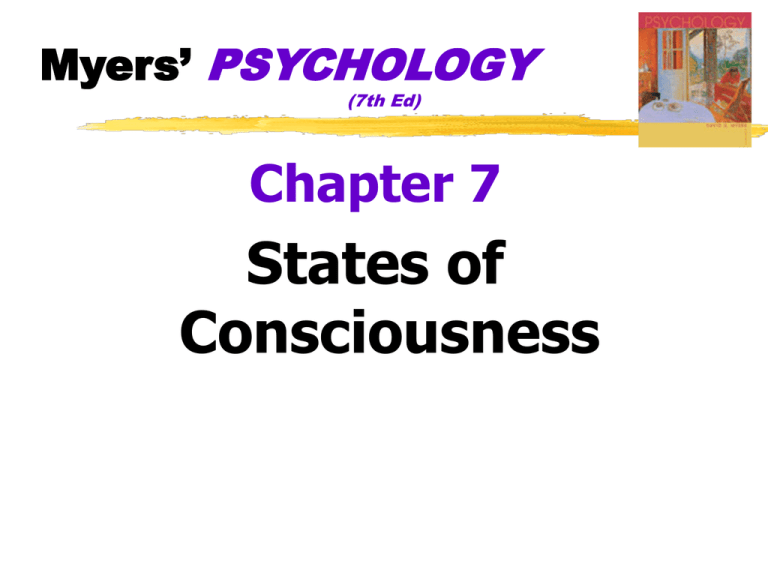
Myers’ PSYCHOLOGY (7th Ed) Chapter 7 States of Consciousness Waking Consciousness Consciousness our awareness of ourselves and our environments Construct – a concept that requires a belief in something that can’t be seen or touched but does exist. What examples of constructs can you think of? Original definition of Psychology: –”the description and explanation of states of consciousness” Behaviorism felt psychology should be an objective science, without reference to mental processes…so new definition: “the science of behavior.” so psychology now becomes the study of observable behavior. In 1960, mental processes renter the picture. Neuroscience related brain activity to various mental states: waking, sleeping & dreaming. Researchers studied to study altered states of consciousness: hypnosis, drugs & alcohol. Levels of Consciousness Conscious-awareness of what is going on in ourselves & our environment. Non-conscious-bodily processes controlled by your mind that you are not aware of: heartbeat, respiration & digestion. Subconscious-consciousness that is just below our present level of awareness: Example: reaching for thinking without thinking, driving home and not remembering stopping at a red light. Unconscious mind contains information, thoughts & desires about which we have no direct knowledge. It contains the: Intuition-though that does not rely on logic or a rational evaluation of events. It is just a feeling. What is sleep? A state of consciousness because we are less aware of our environment & ourselves thane we are in our normal awake state. It is a natural, reversible loss of consciousness. Sleeps helps us to recuperate & restore body tissues. It plays a role in our growth process. All creatures are under the control of: Biological Rhythms periodic physiological fluctuations Internal, chemical units that control regular cycles in parts of the body. The human body goes through a natural 25 hour sleep-wake cycle but earth runs on a 24 hour light-dark cycle. Humans have adapted. Circadian Rhythm the biological clock regular bodily rhythms that occur on a 24-hour cycle, such as of wakefulness and body temperature Sleep cycle: about every 90-100 minutes we pass through a cycle of 5 distinct sleep stages BRAIN WAVES While we sleep our brain has electrical activity in which researchers record. Beta waves are awake brain waves. Stages of Sleep Twilight Stage or Sleep Onset -when we first lie down, electrical activity in our brains begins to slow down, brief transition stage when first falling asleep. -alpha waves are produced. It is the stage between wakefulness and sleep. We let our minds wander and totally relax. Stage 1 Sleep Last about 5-10 minutes. We lose perception of time. Can experience hallucinations or a sensation of falling or floating. Alpha waves are produced. Waves get slower and higher in amplitude. STAGE 2 SLEEP LAST ABOUT 20 MINUTES. CAN BE AWAKENED WITHOUT DIFFFICULTY. BRAIN WAVES ARE CHARACTERIZED BY SLEEP SPINDLES. TALK IN SLEEP IN THIS STAGE. Stage 3 Sleep Often referred to as Delta sleep Delta brain waves are emitted. Last for just a few minutes and then moves on to Stage 4 sleep. STAGE 4 SLEEP Lasts for 30 minutes. Stages 3 & 4 together referred to as slow-wave sleep or Delta sleep, due to delta brain waves being emitted. The slower the brain wave, the deeper the sleep. Hard to awaken,become disoriented & groggy. Sleepwalking occurs in this stage Will be physically tired or ill if deprived of. Increasing amount of exercise, increase time in 3 & 4 sleep. Upon reaching stage 4 and after about 90 to 100 minutes of total sleep time, sleep lightens, returns through stages 3 and 2 REM sleep emerges, characterized by EEG patterns that resemble beta waves of alert wakefulness muscles most relaxed rapid eye movements occur dreams occur Four or five sleep cycles occur in a typical night’s sleep - less time is spent in slowwave, more is spent in REM Sleep and Dreams REM (Rapid Eye Movement) Sleep recurring sleep stage vivid dreams “paradoxical sleep” muscles are generally relaxed, but other body systems are active Sleep periodic, natural, reversible loss of consciousness Sleep and Dreams Measuring sleep activity Brain Waves and Sleep Stages Alpha Waves slow waves of a relaxed, awake brain Delta Waves large, slow waves of deep sleep Hallucinations false sensory experiences Stages in a Typical Night’s Sleep Awake Sleep stages 1 2 3 REM 4 0 1 2 3 4 Hours of sleep 5 6 7 Stages in a Typical Night’s Sleep Minutes of Stage 4 and REM Decreasing Stage 4 25 20 15 Increasing REM 10 5 0 1 2 3 4 5 Hours of sleep 6 7 8 Sleep Deprivation Effects of Sleep Loss fatigue impaired concentration & memory depressed immune system greater vulnerability to accidents Sleep Deprivation Less sleep, more accidents Accident frequency More sleep, fewer accidents 2,800 2,700 4,200 2,600 4000 2,500 3,800 2,400 3,600 Spring time change (hour sleep loss) Monday before time change Fall time change (hour sleep gained) Monday after time change Sleep Disorders Insomnia persistent problems in falling or staying asleep during the night Most common/affects 10% of population Treat with a change in habits Narcolepsy uncontrollable sleep attacks, suffer from intense periods of intense sleepiness will fall asleep at unpredictable & inappropriate times rare, occurs in 1 in 2000 people will fall immediately into REM sleep treat with medication & a change of sleep patterns. Sleep Apnea almost as common as insomnia (1 in 25) temporary cessation of breathing for short periods of time during the night This causes person to wake up slightly, gasp for air & return to sleep, robbing a person of deep sleep, causing fatigue, attention & memory problems Night Terrors and Nightmares Night Terrors Sleep stages Awake 1 2 3 REM 4 0 1 2 3 4 5 6 Hours of sleep 7 occur within 2 or 3 hours of falling asleep, usually during Stage 4 high arousal—sit up in bed appearance of being terrified happens to children only Nightmares Occur during REM sleep 5% of population have them On average pf 1X per week Usually happens when we miss REM sleep, don’t get enough sleep, drink too much alcohol, eat spicy foods, or see something that is scary. Somnambulism Also known as sleepwalking Occurs during Stage 4 sleep Dreams: Freud Dreams sequence of story like images, emotions, & thoughts passing through a sleeping person’s mind hallucinatory imagery discontinuities incongruities delusional acceptance of the content difficulties remembering Lucid Dreams We are aware that we are dreaming and can control the dream. A very difficult area to research Dreams: Freud Sigmund Freud--The Interpretation of Dreams (1900) Symbolic expressions of our unconscious conflicts or wish fulfillment clues to inner thoughts & forbidden impulses discharge otherwise unacceptable feelings Manifest Content remembered story line Latent Content underlying meaning Theories about why we dream 1. Information Processing Perspectivedreams help us sort out the day’s experiences and fix them in memory. 2. Activation-synthesis explanation states that REM sleep triggers impulses in the visual cortex, evoking random visual images that our brain tries to weave into a storyline. 3. The brain-maturation/cognitive development perspective believes dreams represent the dreamer’s level of development, knowledge & understanding 4. Dreaming serves as a physiological function and REM induced regular stimulation helps develop & preserves neural pathways in the brain Most sleep theorists agree that REM sleep and dreams serve an important function, as evidenced by REM rebound that occurs following sleep deprivation. Common dream themes Most dreams about ordinary events Involve our worries, fears, feelings,& arguments. Falling, being chased, flying, losing or finding something, finding yourself naked, teeth falling out are all common dream themes 50% of us dream in color and 50% in black & white. Researchers don’t know why. Sleep Across the Lifespan Hypnosis Hypnosis a social interaction in which one person (the hypnotist) suggests to another (the subject) that certain perceptions, feelings, thoughts, or behaviors will spontaneously occur Used to cure ailments, bring back memories Greek god of sleep-Hypnos Posthypnotic Amnesia supposed inability to recall what one experienced during hypnosis induced by the hypnotist’s suggestion Hypnosis Orne & Evans (1965) control group instructed to “pretend” unhypnotized subjects performed the same acts as the hypnotized ones Posthypnotic Suggestion suggestion to be carried out after the subject is no longer hypnotized used by some clinicians to control undesired symptoms and behaviors Hypnosis Dissociation a split in consciousness allows some thoughts and behaviors to occur simultaneously with others Hidden Observer Ernest Hilgard’s (1904-2001)term describing a hypnotized subject’s awareness of experiences, such as pain, that go unreported during hypnosis Explaining Hypnosis Drugs and Consciousness Psychoactive Drug a chemical substance that alters perceptions and mood,changes the chemistry of the brain Changes our perceptions, mood or behavior Molecules pass through the blood-brain barrier Lead to Physical Dependence physiological need for a drug,to take more marked by unpleasant withdrawal symptoms Psychological Dependence a psychological need to use a drug for example, to relieve negative emotions Dependence and Addiction Big effect Drug effect Tolerance diminishing effect with regular use Response to first exposure Withdrawal After repeated exposure, more drug is needed to produce same effect Little effect Small Large Drug dose discomfort and distress that follow discontinued use Psychoactive Drugs Depressants drugs that reduce neural activity slow body functions alcohol, barbiturates, opiates Stimulants drugs that excite neural activity speed up body functions caffeine, nicotine, amphetamines, cocaine Psychoactive Drugs Hallucinogens psychedelic (mind-manifesting) drugs that distort perceptions and evoke sensory images in the absence of sensory input Does not slow or speed up the body LSD, peyote, mushrooms, ecstasy Psychoactive Drugs Barbiturates drugs that depress the activity of the central nervous system, reducing anxiety but impairing memory and judgment Psychoactive Drugs Opiates opium and its derivatives (morphine and heroin, methadone) opiates depress neural activity, temporarily lessening pain and anxiety Elevate endorphins, mood elevators Psychoactive Drugs Amphetamines drugs that stimulate neural activity, causing speeded-up body functions and associated energy and mood changes Cocaine Euphoria and Crash Psychoactive Drugs Ecstasy (MDMA) synthetic stimulant and mild hallucinogen both short-term and long-term health risks LSD lysergic acid diethylamide a powerful hallucinogenic drug also known as acid THC the major active ingredient in marijuana triggers a variety of effects, including mild hallucinations Psychoactive Drugs Trends in Drug Use 80% High school seniors reporting drug use 70 60 50 Alcohol 40 Marijuana/ hashish 30 20 Cocaine 10 0 1975 ‘77 ‘79 ‘81 ‘83 ‘85 ‘87 ‘89 Year ‘91 ‘93 ‘95 ‘97 ‘99 Perceived Marijuana Risk 100% Percent of twelfth graders Perceived “great risk of harm” in marijuana use 90 80 70 60 50 40 Used marijuana 30 20 10 0 ‘75 ‘77 ‘79 ‘81 ‘83 ‘85 ‘87 ‘89 ‘91 ‘93 Year ‘95 ‘97 ‘99 Near-Death Experiences Near-Death Experience an altered state of consciousness reported after a close brush with death often similar to druginduced hallucinations Near-Death Experiences Dualism the presumption that mind and body are two distinct entities that interact Monism the presumption that mind and body are different aspects of the same thing

